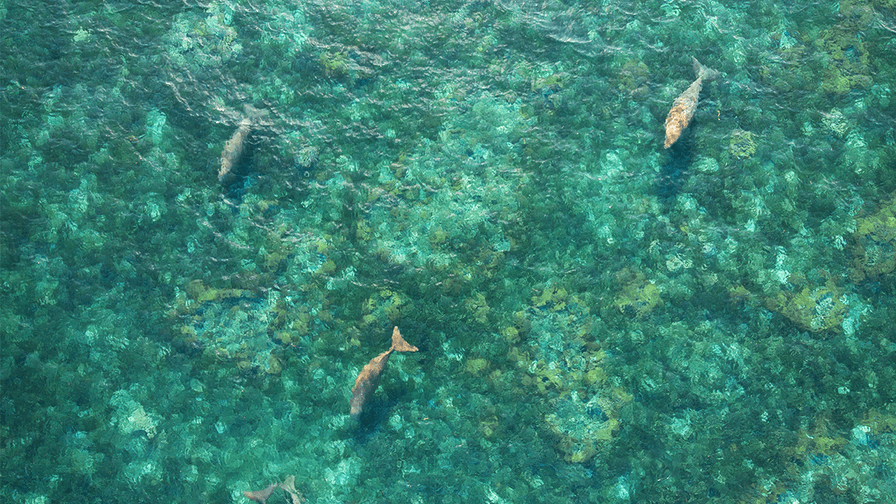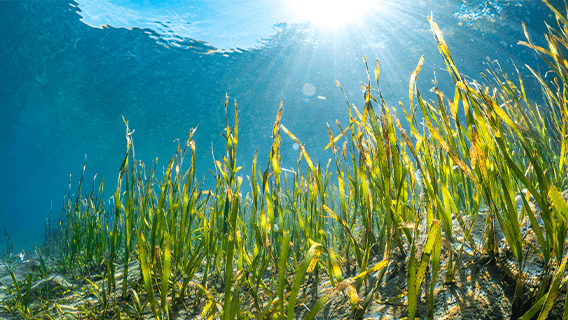Unlocking the value of nature in India’s Palk Bay
A new study is exploring how carbon credits can create new revenue streams for conservation

Our ocean is home to 80% of all life on earth and supports the livelihoods of more than three billion people. As a large carbon sink, it provides natural, at-scale solutions to help address climate change.
Despite its importance, ocean health is rapidly declining, whilst ocean conservation, research and sustainable development remain alarmingly marginalised and underfunded.
The World Economic Forum found an estimated cumulative funding gap of at least USD900 billion between now and 2030 for Sustainable Development Goal 14 (“Life Below Water”).
Overcoming the barriers to restoring ocean health requires an integrated approach, notably to bridge the existing funding gap to effectively implement interventions.
With a market footprint that is approximately 90% coastal, we, at Standard Chartered, are working across our business and with our clients to mobilise funding towards our ocean for the development of a sustainable blue economy by leveraging innovative mechanisms which could unlock much-needed capital flows.
Robust scientific research has a significant role to play in grounding the development of innovative financing mechanisms and, in turn, attracting private investment. In this vein, and as part of a broader effort to build scalable, high-integrity carbon markets, we are supporting a new study that will explore the feasibility of leveraging blue carbon credits to support conservation and restoration in the Palk Bay Dugong Conservation Reserve in India.
What are carbon credits and how can they be blue?
- Carbon credits are based on a tonne of carbon dioxide emissions avoided, removed or reduced.
- They have increasingly been derived from natural sources, known as nature-based solutions, which sequester (lock away) carbon dioxide.
- Blue carbon is carbon dioxide sequestered by marine ecosystems , including seagrass meadows, seaweed and mangrove forests.
- Nature-based carbon credits can support the mitigation of the twinned crises of nature loss and climate change by supporting ecologically important habitats by generating revenue streams to finance restoration and conservation activities.
- They can also be used to support indigenous peoples and local communities through equitable disbursement of revenues generated by nature-based carbon credits.
A unique ecosystem
The Palk Bay Dugong Conservation Reserve is a 448km2 coastal reserve between India and Sri Lanka. It is home to a myriad of endangered marine creatures, such as dolphins, sea turtles, porpoises, and approximately 40 per cent of India’s dugong population. The Palk Bay region also has one of the largest seagrass beds in the world.
What is seagrass and why is it important?

Seagrass – not to be confused with seaweed – is a grass-like plant which grows in shallow water. In abundance, seagrass can form thriving meadows, some of which are large enough to be seen from space.
They form some of the most productive ecosystems in the world by providing ample conditions, food and shelter for a diverse community of species to flourish.
Seagrass can sequester and store carbon dioxide, absorbing it through the surrounding water, the seabed and sediment, acting as a nature-based solution to climate change. Located in waterways, the ocean or other bodies of water, carbon dioxide sequestered by seagrass is labelled as “blue carbon”.
Although seagrass covers a very small amount of the world’s ocean bed, with some estimates being as small as 0.1 per cent , seagrass currently absorbs 10 per cent of total oceanic carbon.
Despite this, seagrass receives relatively little attention compared to other nature-based solutions.
Beyond climate mitigation, seagrass ecosystems generate further benefits, including supporting commercial fisheries, promoting biodiversity, cleaning surrounding water, and building resilience through adaptive mechanisms.
Palk Bay is home to over 150 coastal villages in Tamil Nadu, where communities have relied on its rich marine resources for generations. Households in this region depend on small-scale fishing, seaweed harvesting, and related activities for their livelihoods. Beyond economic sustenance, these practices are deeply intertwined with the cultural identity and traditions of the local community. However, Palk Bay’s precious habitat is under threat from pollution and unsustainable fishing practices. Fishing nets harm the seagrass in nearshore waters, and once discarded, have a negative impact on marine creatures, including causing fatal entanglements to resident dugongs. Overfishing has also reduced the ecosystem’s resilience and fish populations, threatening widespread poverty among the local coastal communities in the long term.
With more than 50,000 individuals residing along the coast adjacent to the Dugong Conservation Reserve, a sustainable and equitable management plan which promotes sustainable practices and supports local socioeconomic needs will play a vital role in supporting sustainable development in the area. Conservation initiatives that prioritize community involvement like the Dugong Conservation Reserve protects both the ecological integrity of the bay and the socio-cultural fabric of its communities.
By integrating traditional knowledge with scientific approaches, these efforts ensure that conservation measures resonate with local values and practices. Critical to the success of the management plan is the creation of sustainable revenue streams which support the community.
Scoping the feasibility of blue carbon
A new feasibility study, led by The Zoological Society of London (ZSL), the Wildlife Institute of India, the International Union for Conservation of Nature (IUCN) and the Tamil Nadu Forest Department, with support from Standard Chartered, aims to scope the potential blue carbon value which could be derived from Palk Bay’s very own seagrass.
If viable, and with sufficient demand, blue carbon credits derived from the seagrass could catalyse private finance in support of the equitable management plan, helping to incentivise the preservation of the seagrass meadows and create a new, stable revenue stream for the local community.
As revenues from carbon credits may only be realised when credits are successfully sold, it is important to ensure sufficient demand for these credits. While this project could be one of the first to register seagrass restoration carbon credits, the demand for such credits may be demonstrated by the presence of buyer coalitions for blue or nature-based carbon, such as Beyond’s Blue Carbon Buyers Alliance, comprising of major US companies seeking to leverage the voluntary carbon market for blue carbon ecosystem conservation and restoration. Symbiosis is an additional example, comprising of several big-tech players seeking to ensure a high standard of quality across nature-based carbon projects through a strong demand signal and willingness to pay. In the long-run, to ensure sustainable demand, allowing these credits to be used in carbon compliance markets will be required.
Tranches of carbon credits from a mangrove restoration project in neighbouring Pakistan have already sold on Climate Impact X, the carbon marketplace jointly developed by Standard Chartered, DBS, SGX and Temasek in 2021, demonstrating existing market appetite.
Beyond buyers, the carbon credit landscape will also benefit from the continued improvement and refinement of methodological work to support carbon verifying standards with the scientific robustness that establishes confidence in the investor community.
This feasibility study serves as part of Standard Chartered’s efforts to develop high-integrity carbon markets. In 2024, we delivered a first-of-a-kind financing solution for carbon removals with British Airways, CUR8 and UNDO. Leveraging the learnings from the transaction, we are working to replicate similar structures for nature-based solutions.
Local stewardship at the heart of a new sustainable management plan
An equitable and sustainable management plan for Palk Bay – informed by the feasibility study – ensures that conservation and community well-being are mutually reinforcing goals. Supporting practices that allow marine ecosystems to recover enables communities to manage stocks more sustainably, provide alternative revenue streams, working to protect – or even grow – income sources for local families. These approaches reduce economic vulnerability and promote food security for the region’s fishing villages.
Additionally, inclusive management planning that includes local voices in governance fosters a sense of ownership, builds trust, and strengthens the social fabric of coastal communities. When paired with innovative financing mechanisms like blue carbon credits, such plans can channel resources directly into community-led development, supporting education, healthcare, and preservation of cultural heritage. Through this, an equitable management strategy transforms conservation from a top-down directive, into a participatory pathway for dignity, resilience and long-term prosperity.
This feasibility study is now under way, and if successful, could be transformative in creating long-term economic security and enhancing the resilience of the local community, and other conservation efforts alike.
Standard Chartered has an important role to play in supporting our clients, sectors and markets to deliver net zero, but to do so in a manner that supports livelihoods and promotes sustainable economic growth. We currently provide financial services to clients, sectors and markets that contribute to greenhouse gas emissions however we’re committed to net zero in our own operations by 2025 and in our financed emissions by 2050.
Learn more about how we’re channelling capital towards our ocean.